| Rubus chamaemorus | |
|---|---|
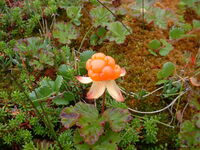 Ripe cloudberry | |
| Conservation status | |
| Taxonomy | |
| Kingdom | |
| Phylum/Division | |
| Class | |
| Order | |
| Family | |
| Genus |
Rubus |
| Species |
R. chamaemorus |
| Naming and discovery | |
| Botanist |
L. |
Rubus chamaemorus (cloudberry or bakeapple) is a rhizomatic plant native to the alpine and arctic tundra, and the taiga, with an amber-colored fruit which looks similar to a raspberry or blackberry.
The cloudberry can grow to 10-25 cm high. The leaves are alternate between having 5 and 7 soft lobes, on straight branchless stalks. After pollination, the white, sometimes red-tipped flowers form berries the size of a raspberry. Encapsulating between 5 and 25 drupelets, each fruit is usually pale red, ripening into an amber color in autumn.
Distribution and ecology[]

Distribution of R. chamaemorus
Cloudberries naturally occur from 78°N to 55°N, and are very scattered at 44°N in mountainous areas. In Europe, they grow in the Nordic countries, especially in Finland and often in the Baltic states; sometimes in the moorlands of Britain and Ireland, and across northern Russia to the Pacific Ocean. Small amounts are found south as a botanical vestige of the Ice Ages; it is found in Germany's Weser and Elbe valleys, where it is legally protected. In North America, cloudberries grow in Canada, Alaska, and parts of the contiguous United States, in Minnesota, New Hampshire, Maine, and Long Island, New York.
The cloudberry can survive down to -40°C, but is sensitive to salt and to dry conditions. It grows in bogs, marshes, and meadows, and requires exposure to the sun in acidic soils between 3.5 and 5 pH.
The leaves of cloudberries are food for caterpillars of several Lepidoptera species. The cloudberry is the only plant species the moth, Coleophora thulea feeds on.

Wild cloudberries in Norway
Unlike most members of the Rubus genus, the cloudberry doesn't self-pollinate. In order for pollination to occur, a plant of the opposite sex needs to be present. The wide distribution occurs because capsules are opened by birds and animals, and then indigestible seeds are released through the animals' feces. Further distribution arises through its rhizomes, which can develop extensive berry patches. Cuttings of these can also be taken, and when planted can produce a genetic clone to the parent plant.
Uses[]
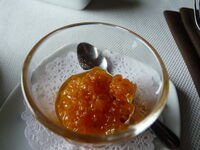
Moroshka Varenye, a cloudberry jam
The ripe fruits are golden-yellow, soft and juicy, and are rich in vitamin C. When eaten fresh, cloudberries are very tart. When over-ripe, they have a creamy texture and flavour similar to yogurt. They are often made into jams, tarts, juices, and liquors. In Finland, they are eaten with leipäjuusto and cream and sugar. In Sweden, they are used as a topping for ice cream or waffles. In Norway they are mixed with whipped cream and sugar to make a dessert called multekrem. They are often added to cakes with marzipan in them. In Canada, they are used to flavour beer. Canadians also make them into jam, but not as much as the Scandinavians. In Alaska, they are mixed with seal oil, reindeer or caribou fat, and sugar to make Agutak. Due to its amount of vitamin C, the berry is valued by Nordic seafarers and the Canadian Inuit to protect against scurvy.
Tea made from cloudberry leaves were used in Scandinavian herbal medicine to cure urinary tract infections.
Alcoholic drinks[]
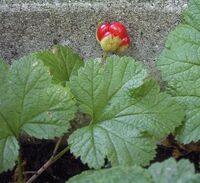
Unripe fruit
In Nordic countries, they are often used in liquors such as Lakka. This has a strong taste and a high sugar content. It is also used as a spice for akvavit.
Dogfish Head Brewery has made an Arctic Cloudberry Imperial Wheat beer which was inspired by the Soleil de Minuit beer by Brasserie Cantillon for an Akkurat pub in Stockholm.
Rodrigues Winery in Newfoundland, Canada makes a cloudberry wine and liquor with cloudberries grown in Newfoundland and Labrador.
Grythyttans vin of Sweden a real fermented wine made from cloudberries. This wine is popular with blue cheese and desserts.
A cloudberry liquor known as chicoutai (which is the local name for cloudberry in Quebec) is made in northeastern Quebec, Canada.
IKEA stores in Britain sell a sparkling apple drink with cloudberry flavor which contains 1.2% cloudberry aroma. IKEA also sells a cloudberry jam made in Sweden.
Cultivation[]
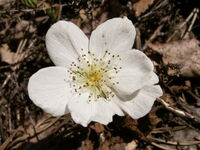
Cloudberry flower (male)
Despite its modern demand as a delicacy exceeding supply, the cloudberry is mainly a wild plant. Wholesale prices vary mostly on the size of the yearly harvest, and can reach to prices of 10€/kg.
Since the middle of the 1990's, the species has formed part of the Northernberries project. The Norwegian government, in cooperation with the Finnish, Swedish, and Scottish governments vigorously pursued aim to commercially produce various wildberries. In 2002, some cultivars were selected for farmers to use, including 'Apolto' (male), 'Fjellgull' (female), and 'Fjordgull' (female). The cloudberry can be cultivated in Arctic areas where few other crops are possible, in places like the northern coastline of Norway.
Other names[]
|
This page contains Inuit text in Inupiaq Without proper rendering support, you may see question marks, boxes, or other symbols instead of syllabics. |
|
This page contains Japanese text. Without proper rendering support, you may see question marks, boxes, or other symbols that are not Japanese text. |
|
This page contains Persian text. Without proper rendering support, you may see unjoined Persian letters written left-to-right instead of right-to-left or other symbols that aren't Persian script. |
Rubus chamaemorus has several common names due to its immense area of distribution.
- Canada: French: plaquebiere, chicoutai or chicoutée (in Quebec) English: bakeapple (in Newfoundland and Labrador and Cape Breton Island)
- Cree Innu: "shikutew"
- Catalan: romegueró de torbera
- Cup'ig: "atsar atsakutag" (plural)
- Czech: ostružiník moruška
- Danish: multebær
- Dutch: kruipbraam, gele bosbraam, gele moerasbraam
- England: Knotberry, Knoutberry
- Estonian language: rabamurakas (commonly used); kaarlad, kaarmed, kaarnad, käbalad, muuramed (locally used)
- Finnish: lakka, suomuurain, hilla, muurain, lintti, valokki, nevamarja
- French: mûre des marais, plaquebière, ronce des tourbières, ronce petit-mûrier, mûre arctique
- German: Moltebeere, Multebeere, Multbeere (from Danish); Torfbeere (peat berry)
- Greek: άγριο βατόμουρο (βατόμουρο)
- Hungarian: törpemálna, sarki szeder, lápi málna, tőzegmálna, mocsári hamvasszeder
- Icelandic: múltuber
- Inari Sami: lyeme
- Inuktitut: aqpik or

- Inupiaq: aqpik
- Irish: eithreog (shléibhe)
- Italian: camemoro, mora arctica, lampone artico, rovo artico
- Jamtlandic: "mylta"
- Japanese: ホロムイイチゴ horomui'ichigo
- Lithuanian: paprastoji tekšė
- Latvian: lācenes, mīklenes, spradzenes, graulenes, šķomenes, šķimenes
- Northern Sami: luomi
- Norwegian: molte, molta, multe, multebær, myrbær (whilst unripe)
- Persian: تمشک قطبی
- Polish: malina moroszka, moroszka
- Portuguese: amora-branca-silvestre
- Russian: морошка (moroshka)
- Sakha: "ыт тиҥилэҕэ" ("yt tingileghe")
- Scotland: Averin, Evron
- Siberian Yup'ik: "akavsik" (plural)
- Skolt Sami: lue'm
- Slovak: ostružina moruška
- Spanish: mora de los pantanos, mora ártica, mora de ronces, camemoro, camemoro ártico
- Swedish: hjortron (commonly used); multebär, myrbär, snåtterblomma, solbär, snåttren/snattren (locally used)
- Turkish: yaban ağaç çileği
- Yup'ik: "naunraq", "atsalugpiaq"
Trivia[]

The national side of a Finnish €2 coin, with R. chamaemorus
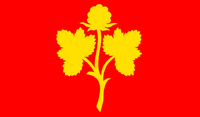
The flag of Nesseby, showing the cloudberry.
Nesseby, a municipality of Norway has a cloudberry on its coat-of-arms. The cloudberry fruit and leaves are also displayed on the Finnish €2 coins. The National Democrats of Sweden use the cloudberry as their logo.
The species name, chamaemorus comes from Greek chamai, meaning on the ground, and moros, meaning mulberry.